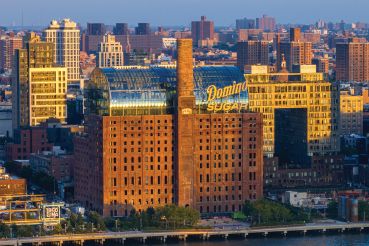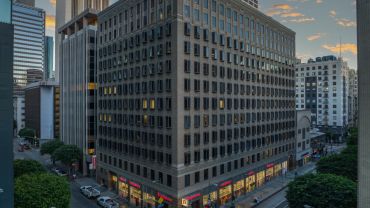 When participants in the commercial real estate market talk about investment sales activity, most focus on the Manhattan marketplace, as this submarket represents the leading indicators of New York City.
When participants in the commercial real estate market talk about investment sales activity, most focus on the Manhattan marketplace, as this submarket represents the leading indicators of New York City.
During the first half of 2010 (1H10), investment sales activity was up significantly from 2009. Granted, we are coming off an extraordinarily low level, but these days, any positive signs are very welcome.
In 1H10, there were $5.2 billion in investment sale transactions in the Manhattan submarket (we define the Manhattan submarket as south of 96th street on the East Side and south of 110th Street on the West Side). This $5.2 billion represents a 170 percent increase over the $1.9 billion in sales that occurred in 1H09. More importantly, the $5.2 billion already significantly exceeds the $4.2 billion in sale transactions that occurred in all of 2009. In 2Q10 alone, there were $3.3 billion in sale transactions, the highest quarterly total going back to 3Q08.
While these totals seem like substantial increases, we must remember that volume remains 83 percent below the peak of the market in 1H07. Then, $30.8 billion in investment sale transactions closed.
Interestingly, the $5.2 billion in sales represented 80 percent of the $6.5 billion in total New York City sales even though the number of buildings in the Manhattan submarket make up only 17 percent of all buildings citywide.
As Massey Knakal has always done, we focus on the number of properties sold, as a few very large transactions can skew dollar volume metrics significantly. In Manhattan, 230 properties were sold in 1H10. This represents an 87 percent increase from the 123 properties sold in 1H09. It was, however, 61 percent below the 597 properties that were sold at the peak of the market in 1H07.
In addition to tracking the number of properties sold, we also look closely at the percentage of the total stock of properties that has transferred. The statistical sample we use for Manhattan contains 27,649 buildings. Of this stock, the 230 sales occurring in 1H10 represent a turnover ratio of 1.66 percent of the stock on an annualized basis.
In the Manhattan submarket, we have been tracking this percentage since 1984. The average turnover, during the 26 years of our study, has been 2.6 percent. This means that the average holding period for an asset in this market has been approximately 40 years.
Prior to 2009, the lowest turnover we had ever seen occurred in 1992 and 2003, when the turnover rate dropped to 1.6 percent. These were both years at the end of recessionary periods and years in which we reached a peak in cyclical unemployment. In 2009, the extraordinarily low supply of available properties helped push the marketplace into new territory, with only 1.17 percent of the total stock selling.
Interestingly, however, throughout 2009 in Manhattan, the volume of sales increased on a quarter-over-quarter basis. Including 1Q10 and 2Q10, we have now seen six consecutive quarters of positive transaction volume, indicating that we are clearly passed the bottom in terms of transaction activity.
PRICING TRENDS ARE less transparent.
Thus far, in 2010, the average price of a property sold in Manhattan achieved a level of $22.6 million, up significantly from 2009’s average of $12.9 million. This figure is still, however, well below the 2007 average of $52.5 million. Citywide, the average price of a building sold in 1H10 hit $7.9 million, up from $4.4 million in 2009, and very close to the 2008 average of $8 million. As financing for larger transactions becomes more readily available, we expect the average price for Manhattan buildings to increase substantially as we move forward.
Clearly, the evidence indicates that we are past the bottom in terms of a low point in transaction activity. As mentioned above, pricing trends are much more difficult to read. As was the case of the end of 1Q10, some property segments, in some markets, have seen increases in value while others continue to find value dropping.
We will take a look at some of these product sectors below.
In the elevator apartment building sector, there were 13 properties sold for a total of about $670 million. Buildings in this sector saw their value fall in 1H10 versus 2009 levels on a price-per-square-foot basis. In 2009, the average elevator apartment building sold for $438 per square foot. This figure dropped to $406 in 1H10, a 7.3 percent reduction in value. Cap rates in this sector showed a modest decline of 6 basis points, going from an average of 4.71 percent in 2009 to 4.65 percent in 1H10. Gross rent multiples also dropped from a 2009 average of 13.3, down 0.8 multiples to 12.51.
Given that price per square foot was down and cap rates were as well, it leads us to conclude that properties with a higher percentage of rent-regulated units were selling in 2010 versus those that were sold in 2009.
In the walk-up apartment building sector, there were 29 properties sold for a total of about $120 million. In this sector, we saw a 9.25 percent increase in value as price per square foot increased, from a 2009 average of $530 per square foot, to $579. Cap rates here expanded significantly, going from a 2009 average of 5.19 percent, up to 5.98 percent, an expansion of 79 basis points. In an opposite trend to elevator properties, here we have seen a greater number of walk-ups with free market apartments selling. This has driven the price per square foot up, in opposition to what cap rate expansion would dictate. Gross rent multiples have also dropped, going from a 2009 average of 12.48, down to 11.34.
A trend that we saw emerge in 2009, in all submarkets, that has continued thus far in 2010, is that walk-up apartment buildings continue to sell for higher prices per square foot than elevator properties.
There are two reasons for this dynamic. The first is that the tenancy turnover in walk-up buildings tends to be much higher than in elevator properties, giving owners the ability to access upside potential more easily. The second reason is that apartments in walk-up buildings tend to be smaller in size than in elevator properties. In an elevator building, a one-bedroom apartment may be 700 square feet as opposed to a one-bedroom in a walk-up, which might only be 350 square feet. While a tenant writes a higher monthly check to live in an elevator building rather than a walk-up, the tenant in the walk-up is actually paying a higher rent per square foot. This translates into a higher value per square foot.
In the mixed-use sector (where retail space makes up at least 20 percent of the square footage of a property), there were 34 properties sold in 1H10 having a total value of about $190 million. The average price per square foot has increased by 6.5 percent, moving to $732 per square foot in 1H10, versus $687 in 2009. The average cap rate on a mixed-use property increased by 83 basis points, growing from a 2009 average of 5.7 percent, to 6.53 percent.


